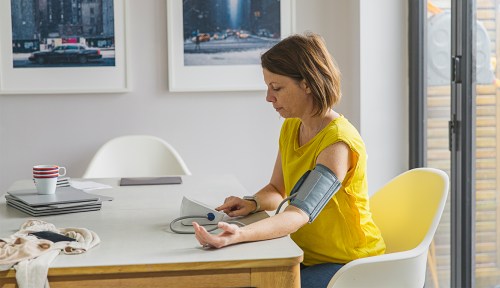If your blood pressure is top-of-mind right now, you’re not alone. Nearly half of adults in the United States have high blood pressure, a condition that puts them at risk for developing heart disease and stroke. A recent study published by the American Heart Association found that blood pressure rates rose among middle-aged American adults during the COVID-19 pandemic.
Experts in This Article
cardiologist and medical director of Non-Invasive Cardiology at MemorialCare Heart and Vascular Institute at Orange Coast Medical Center in Fountain Valley, California
Given just how many people in the country have high blood pressure (also known as hypertension), it’s understandable that you’d start to think about keeping tabs on your blood pressure situation (and exploring diet and exercise habits that might improve cardiovascular health). Luckily, checking your blood pressure is easy enough to do: Most drugstores carry blood pressure monitors you can use at home. But, is this something you should do? Here’s what you need to know about monitoring your blood pressure at home every day—and who can benefit from it—according to cardiologists.
Okay, what is blood pressure?
Your blood pressure is the pressure of blood pushing against the walls of your arteries, according to the Centers for Disease Control and Prevention (CDC). Your arteries, in case you’re not familiar with them, are tiny tubes in your body that carry blood from your heart to other parts of your body.
When you have your blood pressure taken, you’ll see two numbers. The first one is your systolic blood pressure, and this number indicates how much pressure your blood is exerting against your artery walls as your heart beats. The second number is the diastolic blood pressure, and it tells you how much pressure your blood is exerting when your heart is resting in between beats. The American College of Cardiology (ACA) and the American Heart Association (AHA) define hypertension as blood pressure at or above 130/80 mmHg. Ideally, you want your blood pressure to be less than 120/80 mmHg, which is what the organizations consider “normal.”
Your blood pressure naturally goes up and down during the day but, if it stays high for more extended periods, it raises the risk of heart damage. In fact, American Heart Association says high blood pressure is a leading cause of heart disease, and nearly 75 percent of all heart disease cases involve high blood pressure levels. And while hypertension doesn’t usually cause symptoms, sometimes high blood pressure can cause ringing in ears and headaches in some people.
When should someone check their blood pressure at home?
“Knowing your blood pressure is helpful for identifying risk factors for cardiovascular diseases, like stroke,” says Jennifer Wong, MD, cardiologist and medical director of Non-Invasive Cardiology at MemorialCare Heart and Vascular Institute at Orange Coast Medical Center in Fountain Valley, California. Technically, anybody can check their blood pressure at home, but cardiologists say there are a few groups that would benefit most:
1. You’ve already been diagnosed with hypertension
“If you have a diagnosis of hypertension and take medicine, it’s useful to have a home blood pressure cuff to check blood pressure periodically and make sure it’s well-controlled,” says Jennifer Haythe, MD, co-director of the Women’s Center for Cardiovascular Health at Columbia University Irving Medical Center and cardiologist at New York-Presbyterian/Columbia.
2. Your blood pressure was high at your doctor’s office, but you’ve never had an issue before
This is what’s known as “white coat hypertension,” which is when your blood pressure goes up at your doctor’s office, Dr. Haythe says. If this happens to you, “it’s helpful to check your blood pressure at home daily for a week and make sure it’s truly normal,” she says.
3. You’re on medication that could raise your blood pressure
Certain medications—including antidepressants and corticosteroids—can raise your blood pressure, says Holly S. Andersen, MD, an attending cardiologist and associate professor of clinical medicine at the New York-Presbyterian Hospital Weill Cornell Medical Center. If you recently went on a new medication with the potential to raise your blood pressure, she says it might be “useful” to take readings at home.
4. You’re pregnant and your last reading was iffy
During pregnancy, you can develop a condition known as preeclampsia, which is high blood pressure when you’re pregnant. People who are pregnant “could benefit from a home blood pressure cuff to make sure they aren’t developing preeclampsia, especially toward the last several weeks of pregnancy,” Dr. Haythe says.
5. You have a lot of risk factors for hypertension
A range of things that can put you at a higher-than-normal risk of developing hypertension, including having diabetes, eating an unhealthy diet, having obesity, and not being as physically active as you should. Even drinking alcohol can increase high blood pressure, according to the CDC.
6. You never go to the doctor
It’s generally recommended that you see your primary care physician at least once a year, but “younger people don’t usually go the doctor as much,” Dr. Wong says. If you don’t see your GP often and you have risk factors for high blood pressure, “having a home monitor can be useful,” Dr. Wong says.
5. Tips for checking your blood pressure at home
1. Try to check around the same time
“It is good to do this at the same time each day as your blood pressure changes throughout the day,” Andersen says. Just a heads up, though: It’s best not to take your blood pressure first thing. “Your blood pressure after awakening is most often the highest blood pressure of the day,” Dr. Andersen says.
2. Make sure you’re seated
The AHA recommends sitting with your back straight and supported (i.e., on a dining chair, not a sofa). Your feet should be flat on the floor, and your legs should not be crossed. You’ll want your arm supported on a flat surface like a table with the upper arm at heart level
3. Wait a few minutes before you take your reading
The AHA recommends emptying your bladder and having five minutes of “quiet rest” before taking your measurements. “You want to be relaxed,” Dr. Wong says. “Your physical activity and stress can affect the reading.”
4. Take two to three readings, a minute apart
The AHA suggests taking two to three readings, with a minute break in between. Andersen recommends taking off the cuff completely between readings. “Leaving it on, partially inflated, will alter the readings,” she says. By the way, “if the results vary significantly, there is something wrong with the device,” Dr. Haythe says.
5. Don’t drink caffeine or exercise 30 minutes beforehand
“Caffeine can elevate your blood pressure, so it is best to avoid for 30 minutes before taking your reading,” Dr. Andersen explains. “Your blood pressure increases as you exercise, and it will take a few minutes for it to return to baseline.”
If you find that your blood pressure is consistently high, it’s time to call your doctor, Dr. Wong says. “You’ll want to see your doctor and come up with a treatment plan,” she says. “We tend to start with lifestyle modifications and go from there. But getting treated is crucial.”
Oh hi! You look like someone who loves free workouts, discounts for cutting-edge wellness brands, and exclusive Well+Good content. Sign up for Well+, our online community of wellness insiders, and unlock your rewards instantly.
Sign Up for Our Daily Newsletter
Get all the latest in wellness, trends, food, fitness, beauty, and more delivered right to your inbox.
Got it, you've been added to our email list.











